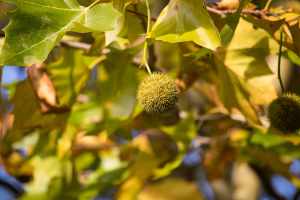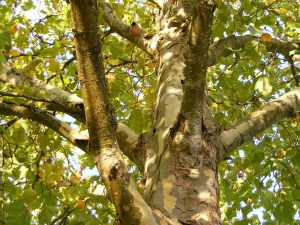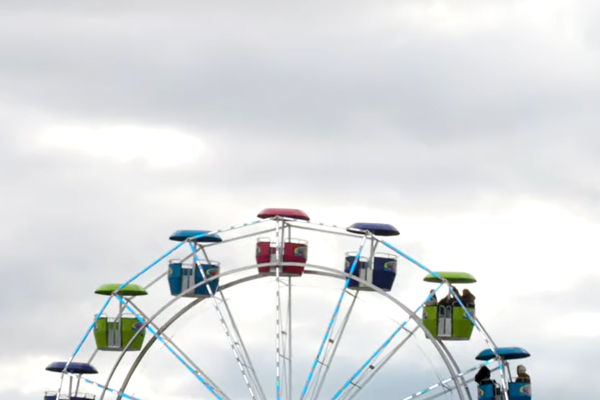Trees are significant for survival. It acts as a physical filtrate that absorbs all the harmful gases, pollutants, and carbon dioxide keeping the environment clean and worth living. While every tree is special in its own way, some just top the list of benefits. Here, we will find out what makes the London plane tree special.
The plantation of trees is necessary to reduce global warming by storing the carbon in the wood of the tree and not releasing them directly into the atmosphere. It absorbs a thousand tonnes of stormwater into the stem, which reduces flood and soil erosion.
London Plane trees are essential and valuable for their ability and adaptability to urban areas. The urban areas emit a large amount of pollution and harmful gases. This tree acts as a resistor to pollution and harmful substance. Thus, it is essential to plant such trees in the streets of large urban cities like, particularly London.
Table of Contents
What is special about the London Plane Tree?
The London plane tree is usually a large deciduous tree with a trunk of three meters. It has a length of 10ft with bark that is usually pale green or buffing brown, soft and exfoliating non-exfoliating in nature.
The leaves have a stiff texture and thick palate lob. The leaf blade is 10 to 12 cm long and 12 to 25 cm broad with a petiole of three to 10 cm long. The young leaves grow minute, stiff and tiny hairs in spring which fall off during the summer.
The flowers are born in one or two dense spherical inflorescences on a pendulous stem, with male and female flowers standing separately in each stem. The fruit takes around six months to mature with a diameter of two to three cm.
It comprises a dense cluster of achenes with many stiff hairs, which helps in wind dispersal. Lastly, the cluster of achenes breaks during the winter season to release many seeds with a circumference of two to three mm.

Origin of London Plane Trees
In the 17th Century, the hybridization of P. Orientalis and P. Occidentalis was done to produce London plane tree species. However, John Tradescant found the tree in mid-17th Century at Vauxhall Garden in London, found in Spain.
The procedure is reciprocal controlling pollination between P. Orientalis and P. Occidentalis is a success. It produces a fruitful output of high-quality yielding of germinable seeds and good hybrid seedlings.
The cross-pollination of both the same species, female of P. racemose and P.wrightii, produces meager yield germinable seeds. However, both the procedure of cross-pollination produces the same result with a variance in quality and yielding of it.
The procedure of Cultivation of London Plane trees
From a historical point of view, the London planes are among the 50 trees under the tree council in 2002 to honor Queen Elizabeth II’s Golden Jubilee.
The plantation of these trees started in Victorian times. It is essential to control the weather and pollution of the atmosphere. Nowadays, the extensive cultivation of the London plane is mainly done in temperate latitudes as an ornamental and parkland tree.
The plantation of these plane trees is generally done in temperate latitudes and regions like London and other large and urban cities. It also has a higher tolerance to winter and cold.
The tree resists wind, but it comes with few drawbacks. The stiff hairs of the leaves shed off during the summer by replacing them with young and fresh leaves. This hair spreads in the atmosphere and irritates the lungs, leading to breathing problems and asthma. The large leaves may create a problem due to the late disposal as the leaves are tough and take time to break down.
London plane trees get better with the procedure of pollarding. It is done because a pollard tree has a different appearance and outlook, which an unpruned tree doesn’t have.
However, pollarding requires frequent maintenance, and the trees are also shorter in height. It also creates a distinctive shape sought around the plazas, main streets, buildings, and other urban areas. These trees are also known as Platanus and Hispanica.

Characteristics of London Plane Species
- The trees have large and prominent leaves
- These trees have dapple bark where the color changes with the seasons
- The trees will have fruits in the shape of a pendant
- These trees will have a branching pattern during winter in the form of an attractive crown
- The trees strive throughout the season
Types of plane trees
Plane trees generally have six to 10 species in the name of Genus Platanus. The fossils confirm Platanus as an ancient genus of flowering and plane trees for more than 100 million old.
According to recent reports, there are two types of Platanus:
- Platanus Kerii is from the native state of East Asia. It is an evergreen tree that originates in South-Eastern Asia.
- Platanus Orientalis is a species that comes from the native state of western Asia. Platanus Orientalis is the plane oriental tree. It has a height of 30m with massive squat boles, some with a diameter or circumference of 10m. The seed is bristly and ball-shaped.
Other types of species
There are other types of species as well available or originates from North America:
- California Sycamore is also known as Platanus Racemosa. These types of trees have contoured branches and thick leaves. It has bristly and ball-shaped seeds in various groups starting from two to seven.
- Arizona Sycamore is also known as Platanus Wrightii. It is sporadic in the United States but primarily grows in Arizona and a considerable population in New Mexico. The native of origin for these trees in north-western Mexico near Sonora and Chihuahua. However, the growth of trees is generally below 6000 feet in various states of Arizona.
- Mexican Sycamore or Platanus Mexicana is a majestic evergreen tree. The average height of the tree lies within forty to a hundred feet with a width or diameter of seventy feet. These trees have very rapid growth and thus grows more than two feet within a year.
- American Sycamore or Platanus Occidentalis. It is also known as buttonwood, whitewood, and buttonball. It is the tallest species among all, reaching heights of 50m at times. The tree is in the shape of a ball or, to say in clarity, the shape of a pendant and smooth to touch, which is usually dangling alone and mainly persist after the leaves fall off.

Condition for growing London plane trees
The flowers which grow in London plane trees are unisexual. In simpler terms, the male and female flowers grow on the same tree but mostly in separate stems. The flowers grow during April. The flowers are spherical, and the male flowers appear in yellow, and the female flower appears in red.
Around October, the female flowers turn into fuzzy balls, which are spherical. It turns into fruity balls which stay like that and survives until winter. These fruity-shaped balls or clusters break up and release two to three mm-sized seedlings during the early winters.
The London plane can grow in various temperate climates that grow best in hardy zones and moderate climates worldwide. The London plane accounts for 10% of tree plantations in New York City.
There are various places worldwide where London plane trees grow, like the North and South America, Australia, and Europe regions. Planting these trees is generally done in large urban cities and communities, which controls the high rate of pollutions.
The favorable condition for these London plane trees to grow is a hot summer, humidity, and sunlight, but they can withstand severe winters as well.
Uses
During the late 17th Century and the start of the 18th Century, Industrial evolution was at its peak, which used to emit tons of harmful substances in the atmosphere and pollute the air. To solve this problem, the plantation of London Plane trees took place, reducing and preventing the massive amount of soot. It also prevents the emission of smoke from machinery and technologies.
Due to Industrial Revolution, the populations were increasing at rapid growth. The need for controlling pollution with a healthy environment for the population to thrive long was increasing. Thus, the London plane grew to act as a savior.
The wood of the London plane plant is handy and serves various purposes. The trees’ various usage are plywood, veneer, furniture, flooring, carvings, interior trim, carvings, and other small, especially wood objects.
The seasonal perspective
The flowering procedure occurs in various seasons and takes a long time. Flowering generally occurs in spring. The process occurs in April and May in the southern hemisphere and September and October in the northern hemisphere.
After the flowering procedure, the leaves begin to grow in warmth and sunlight during the summer season. In the autumn season, the leaves change their colors. The leaves fall apart during the winter season. The advantage of the London plane plants is that they nurture in summer seasons and give good fruits and flowering that survive for a long time.
Various places where London plane tree grows
Not only London, but there are also various places where this tree grows in different textures, forms, and benefits:
New work City
According to the New York City Department of Parks and Recreation reports, the symbol of the leaf is a cross between the maple leaf and London Plane. These trees are present on the New York City Parks Department’s list, restricting the cutting down of these trees across the streets. These trees are essential because it protects the environment and people.
Australia
In Australia, the trees grow in various parts of the country like Sydney, Melbourne, Perth, and Adelaide. The plantation of London Plane Species is more because of its capability to withstand or resilience in hot weather conditions. The benefits are it acts as a shade, breakage resistor and prevents pollution from the atmosphere.
Johannesburg
Johannesburg is located in South Africa. The trees grow near the streets of the older suburbs. The manifestation of the trees is done to a Polyphagous shot hole borer bottle. Although, people of this country believe that the London plane species serve no purpose now.
Timber
If you want to know about Timber, you must know about Lacewood. The Timber has a different, distinctive, decorative, and highly coordinative appearance. The specks are reddish-brown against a very light background which is also known as Lacewood.
In short, various other trees in the world almost serve the benefits. But the London Plane species is the best of all because it reduces more smoke from the air than others.
Development
If someone says that the London Plane is not toxic, the authority might take some legal action. However, there are no legal case records for it to be toxic or harmful to humankind. But the literature review confirms that they are not suitable for health. But, proper scientific research and treatment may change the statement.
The London plane species generally grow and thrive in urban cities like London, America, and Africa, whereas the climatic condition is not humid. Pollution is rising at an alarming rate, and the plantation of more trees is essential. Individuals should start planting London plane species all over the world.
Limitations of London Plane Species:
- The enormous size of the tree may be inconvenient for some locations.
- The bulky and oversized leaves, when they fall off, may clog the drain.
- The shedding of the leaf hair gives serious health effects on humanity.
- London has a shrinking quality of clay soil. This quality can cause considerable and severe issues for building foundations in the uptake of water.
There are some drawbacks, but this is still very useful, and its plantation is still in practice.
To conclude, London Plane Trees has regular and daily use in Greater London. The plantation of this tree is done not only on the streets. But this grows in various places like a cemetery, London squares and gardens, Riverside plantation, and street trees.
Thus, the plantation must be done appropriately to grow more trees in the environment and protect them!




